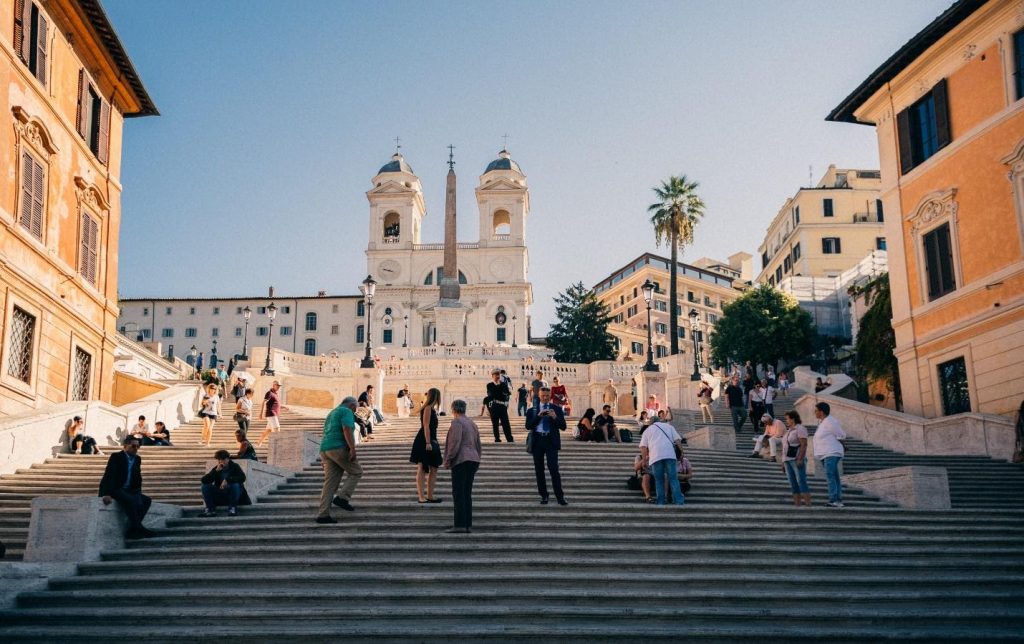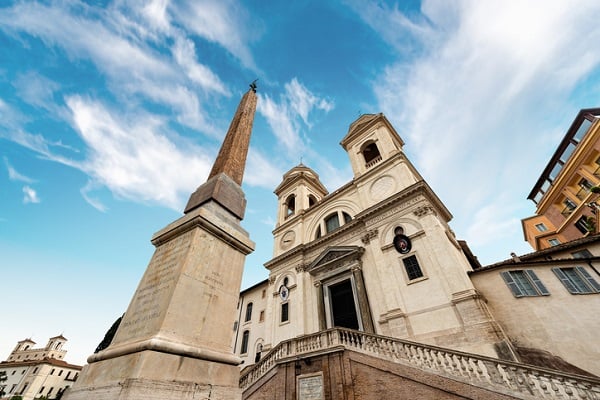

If you want to see Rome’s baroque style up close, this is a must-visit while you study in the Eternal City. The Spanish Steps are a popular meeting spot in Rome and have quite a lot of history behind them. Consisting of 135 steps and shaped somewhat like a butterfly, this Roman landmark connects both the Piazza di Spagna and the Trinità dei Monti—with the latter’s namesake dual-tower church sitting at the top.
Even though you’re no longer allowed to sit on the steps, they’re most definitely still worth a visit and very much deserve their status as a timeless Roman landmark. Here’s what you need to know about the Spanish Steps before your adventure in Rome begins.
Early History and Construction of the Steps
Constructed from 1723 to 1725, the Spanish Steps took influence from a competition-winning design created in 1717 by architect Francesco de Sanctis. It was funded by 20,000 scudi bequeathed by French diplomat Étienne Gueffier, who died in 1660.
The intention behind building these steps was to connect the Spanish Square below them—known as the “Piazza di Spagna”—with the Trinità dei Monti. There had also been plans to erect a statue of King Louis XIV. However, the Pope opposed this, and construction went ahead in 1723 with plans for the statue being left on the cutting room floor.

As opposed to being called the Italian or French Steps, they are dubbed the “Spanish Steps” in reference to the Piazza di Spagna, which had been considered as territory belonging to Spain, and had taken its name from the nearby Palazzo di Spagna. The palace started acting as the Spanish Embassy’s seat for the Holy See in 1647, which it remains today.
The Later History of the Spanish Steps, and Its Appearances in Pop Culture
As the years would go by, the Spanish Steps would gain some further history that could interest anyone about to study in Italy. For example, as you walk up the steps, the adjacent building on the right-hand side is that of famed English poet John Keats, where he lived until his death in 1821. Nowadays, the house acts as a museum featuring plenty of English Romantic memorabilia.
The Spanish Steps were also featured in the 1953 film Roman Holiday, during a memorable scene involving the two main characters (portrayed by Gregory Peck and Audrey Hepburn). 33 years later, the Steps saw protests take place against the opening of the first Italian McDonald’s location nearby, leading to the foundation of the Slow Food movement in 1989 to promote local cuisine.
The Steps’ Modern Appeal for Students Who Study in Italy
Thanks in part to its distinctive design, as well as for being Europe’s widest stairway, the Spanish Steps are a popular spot for creative types such as poets and painters. The Steps continue to attract locals and visitors from many walks of life, helping to solidify their status as a major spot for meeting and people-watching.
However, those who study abroad in Rome should know that you can no longer sit on the steps, as per regulations enforced in 2019 to “guarantee decorum, security and legality”. Sitting on the steps now constitutes a fine of 400 euros. You also cannot eat lunch on the steps, out of respect for maintaining cleanliness. That being said, the steps are certainly worth visiting for those who love photography, as they are adorned by pink azaleas during springtime to commemorate Rome’s foundation. In addition, a crib from the 19th century is placed on the steps’ first level just before Christmas.
Do you want to study at a university in Rome?
Contact John Cabot University to find out more!




